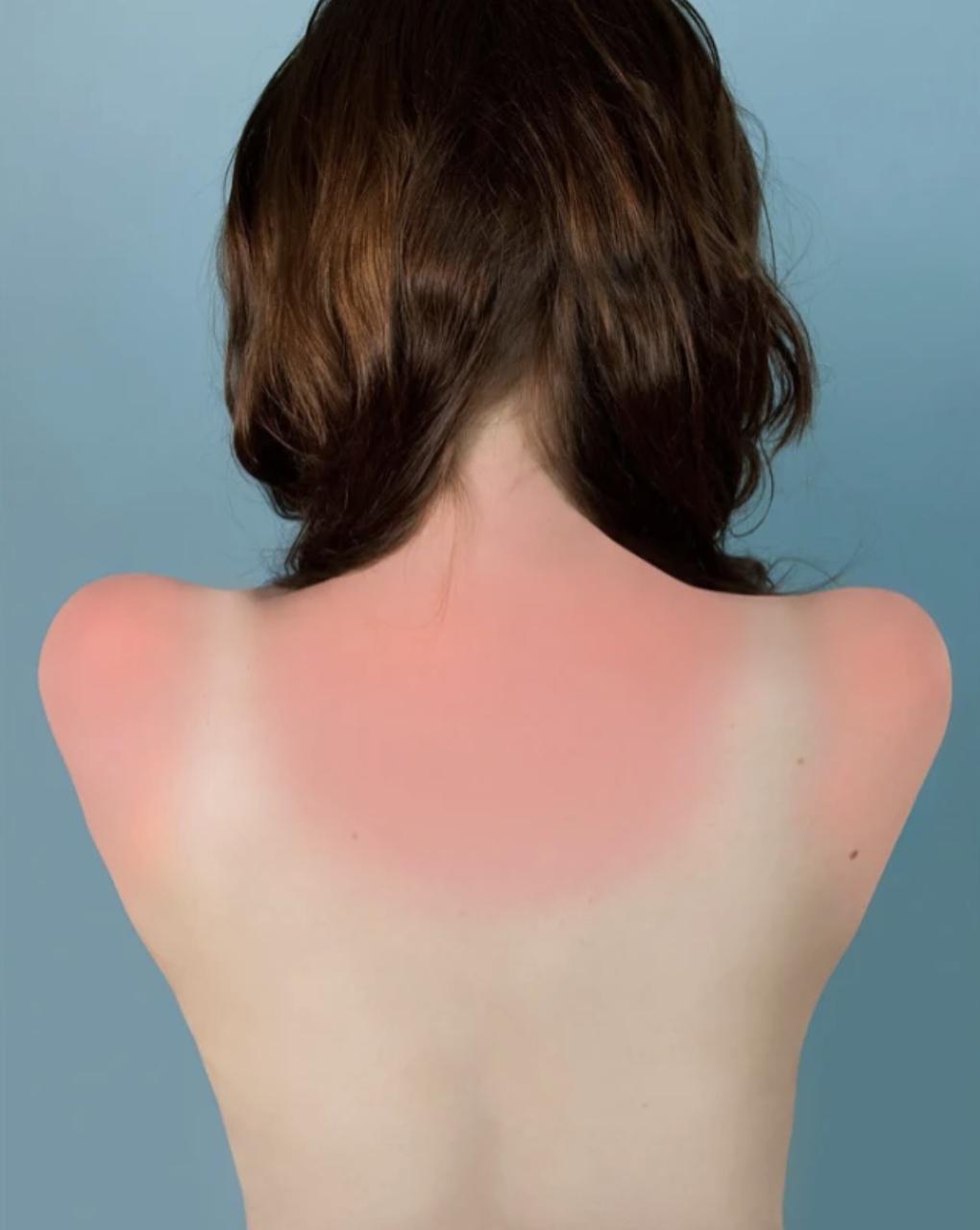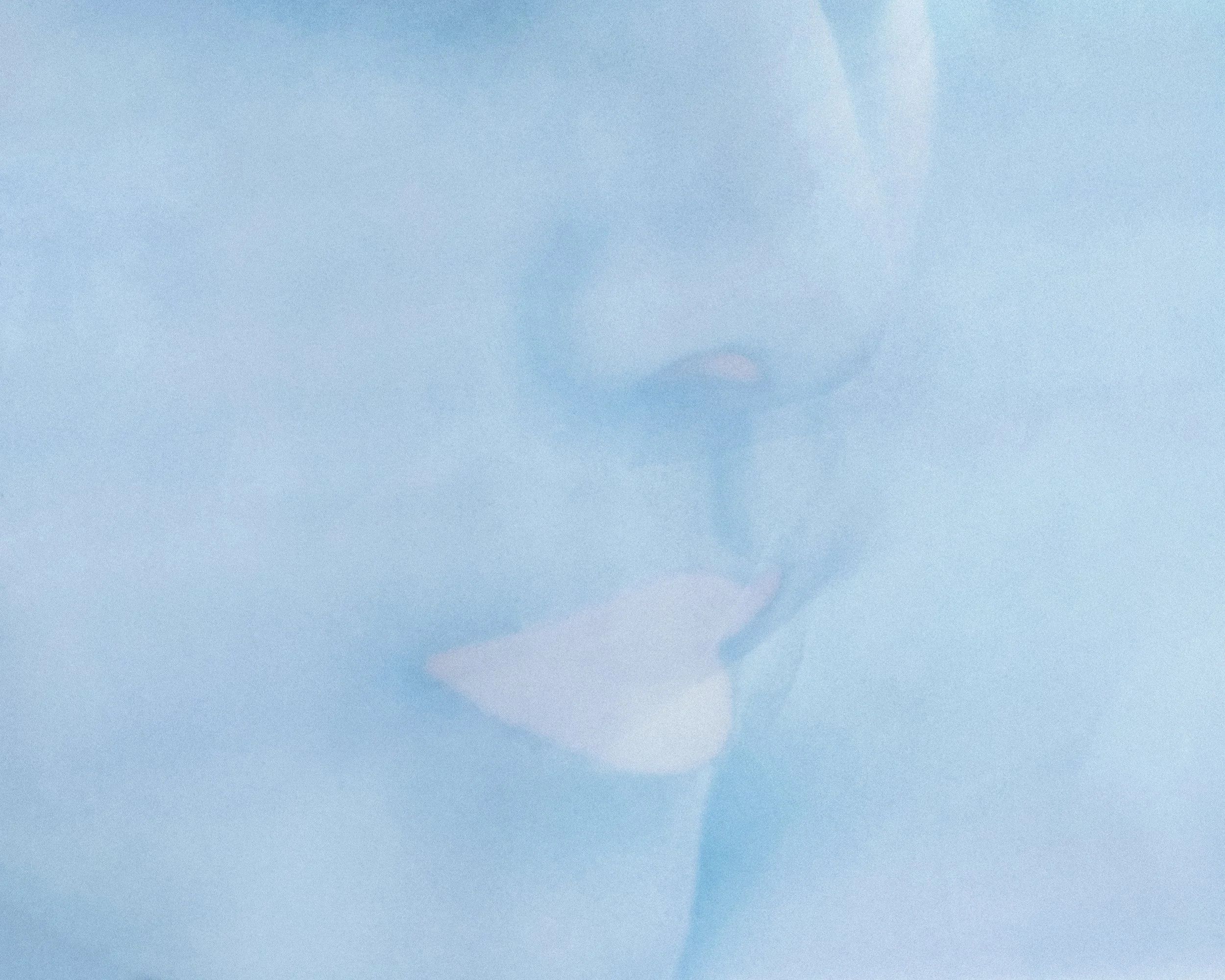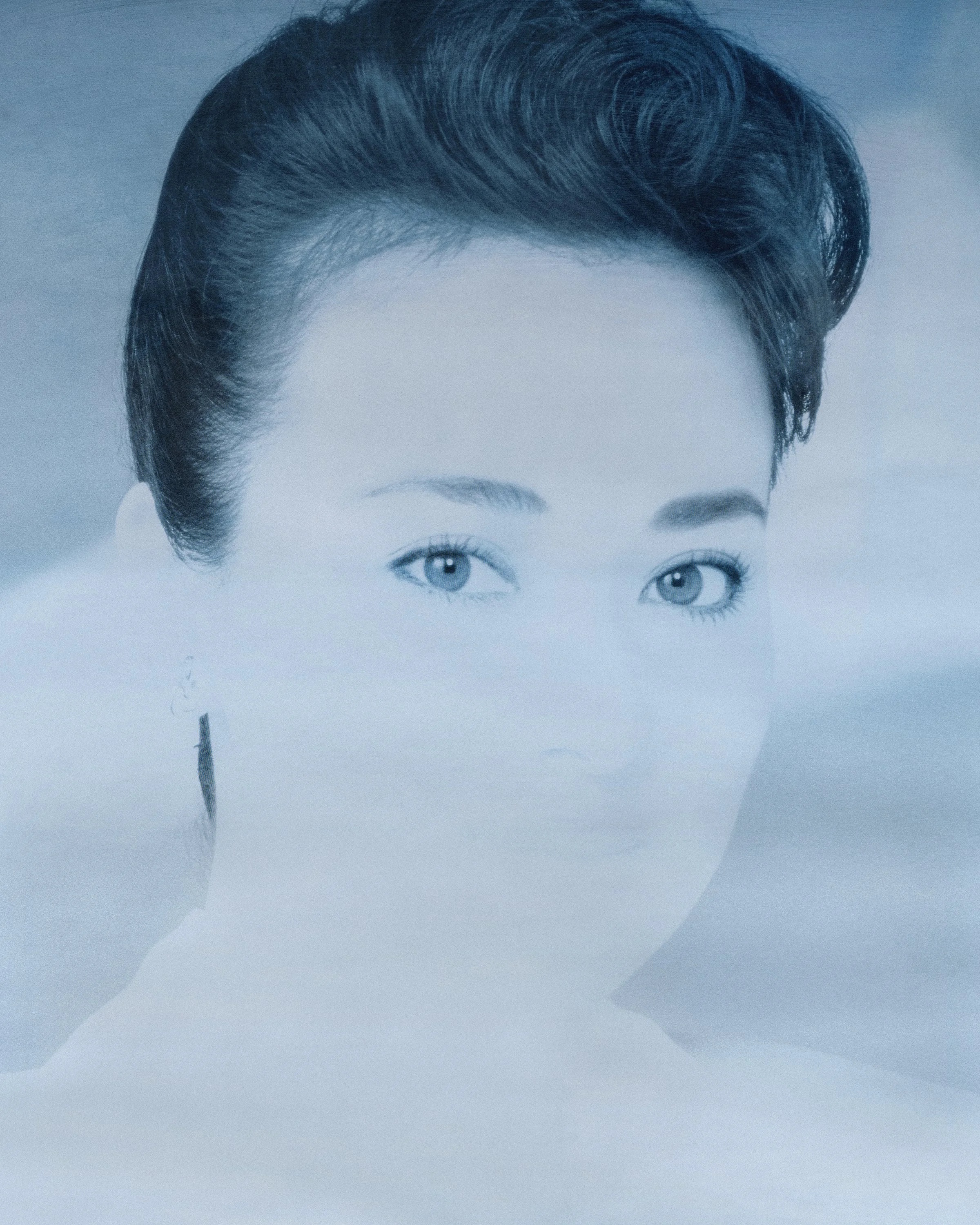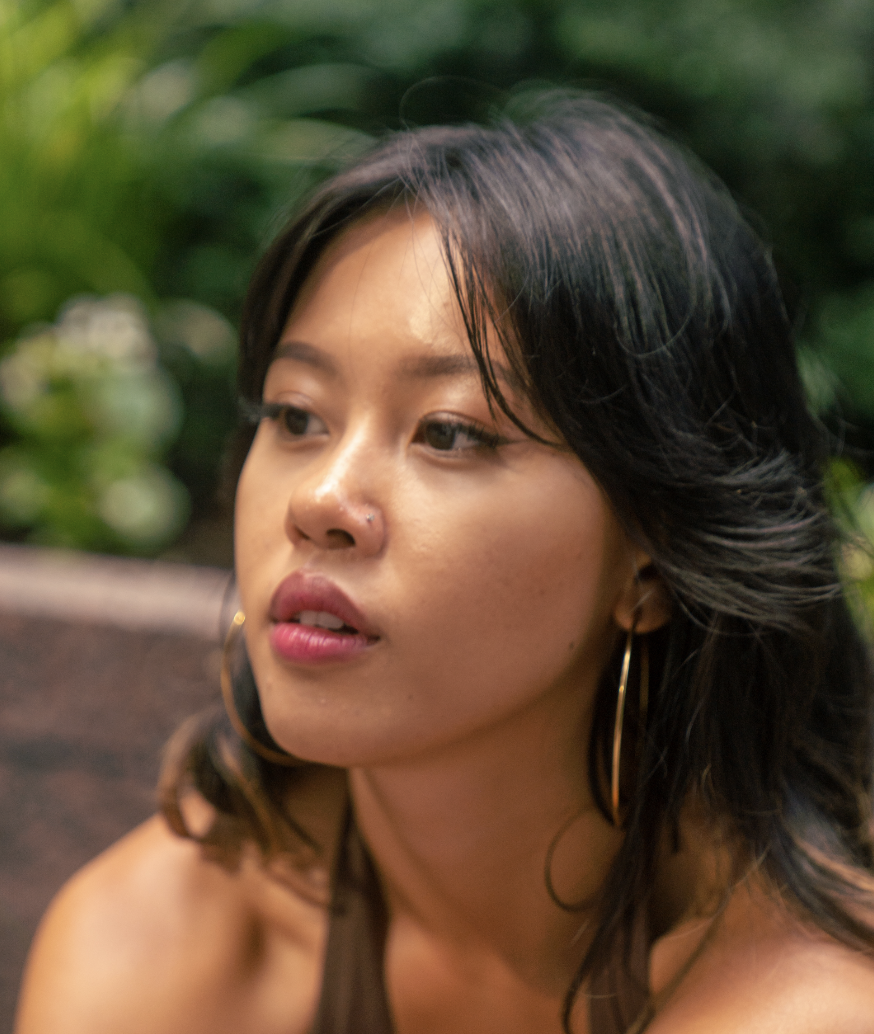At The Hole’s Tiny Vices show in February, I saw Brea Souders’s "Sunburn in Naples" (2010), a back-view photo of a girl’s reddened shoulders and pale mid-back. The girl in the image faces a solid dusty-blue backdrop——a visual allusion to the sky or the Naples shore, although the bright, even lighting seems more indicative of an indoor studio. There is an airbrushed smoothness to both the background and skin (with the exception of a few freckles) that calls attention to the photo’s overall artificiality. And yet, the level of detail in the girl’s hair convinces me of her “realness.”
What I find most fascinating about Souders’s work is how it collapses the distance between reality and fantasy, the human and machine-made. Through a conceptual blend of photography, text, painting, and collage, the artist explores the porousness of these presumed distinctions.
Souders’s latest exhibit at the San Francisco-based EUQINOM gallery, Blue Women, is an archive of re-photographed beauty posters that have been bleached blue by the sun. Through a process of selective documentation, Souders illuminates the layers of digital manipulation and artifice beneath seemingly “natural” commercial images. Exhibited alongside the Blue Women series is Another Online Pervert (MACK, 2023), a book that consists of dialogue with a pre-ChatGPT female AI chatbot and images from Souders’s personal archive, which are reanimated by the text. Both projects are uniquely attuned to the slipperiness of our visual and relational reality.
Souders and I spoke about art-making as an archival impulse, human-AI chatbot relationships, decay, and the importance of going “off-script” for a project.
***
Terry Nguyen: Your opening was this past week in San Francisco. What’s it like having a show there compared to New York?
Brea Souders: San Francisco looks like paradise in some ways, but there’s more going on. Because of the hills, you get these beautiful vistas of the Bay, and then there’s also poverty and homelessness, with self-driving cars and opaque billboards about AI products everywhere too. Most people I talked to love [the self-driving cars by] Waymo. People like that they can play their own music and not talk to a driver. They feel like it’s a private space even though the car has a camera that’s filming you.
TN: That is quite surreal, though on-brand for our conversation: how entirely artificial situations can still feel private or authentic. How did you become fixated on these “blue women,” who may or may not be real people, in beauty store windows?
BS: When I started Blue Women, a big topic in the news was how women’s rights in the U.S. were being attacked. I felt there was a strong emotional tenor to the color blue, and I’d notice these women on my walks. There was a beauty salon in Bushwick that I would walk by and it was plastered with these new posters. At first, none of them were blue, but when I came back maybe six months later, they’d all changed colors.
I began zooming into small sections of the posters so I could examine the digital scaffolding that went into the making of these pictures. A lot of the images are low-resolution so when that’s blown up to 16x20 inches, the pixels and very crude Photoshop manipulations become clear. They’re layered images, and they’re all fading into invisibility: the plants, the women’s faces, their hands.
I was drawn to how the sun, through a completely natural process, assists in revealing this digital manipulation. For me, it’s never as simple as nature = authenticity and technology = artifice. I look for evidence of the two coexisting.

TN: Your previous project, Vistas (2019-2021), also existed in this liminal space between the natural and the machine-made. In Vistas, you hand-painted these photographs of disembodied shadows of hikers in nature that you found on Google Maps. Google’s AI had removed the people’s actual bodies so all that’s left of their physical presence were shadows. It occurred to me that, in Blue Women, you’re another step removed from the images. You’re not physically painting or augmenting them in any way, but curating them.
BS: I think of Blue Women as an index or an archive, although Vistas can also function that way. I find Vistas more realistic than traditional nature photography because it comments on the layering of digital culture with nature and natural degradation. Even those classic Ansel Adams pictures of Yosemite were altered.
In the case of Blue Women, the images had already been augmented or changed in the state I found them, and I didn’t want to interfere. I acted as a mediator through this process of selective cropping, focusing on small areas, zooming into them, and enlarging them later. I highlighted the women’s expressions, their gestures, and the plant life they were surrounded by. To me, these images seem to depict an otherworldly, ghostly realm. I printed them on soft matte paper, different from their original surfaces, so they have more of a tactile, soft quality. I wanted to pull the images further away from their original commercial intentions and into a quieter, introspective space.
I revisited certain images over a period of months or years to witness their changes. While traveling, I would notice recurring photos or symbols, like of a white bird sitting on a woman’s hand, in different cities around the world. I was in Tokyo, Istanbul, Paris, and New York. I first photographed the white bird in Brooklyn, and then in Istanbul I saw the exact same poster but it had faded in a different way. Maybe it had been up for longer, or the poster had more direct sun exposure. I’ve also tried to buy the posters from the shops themselves, but the owners told me no, because customers love them.

TN: Some of the images feel very ‘90s to me, which makes the project feel like a time capsule. Another Online Pervert has that element of nostalgia for me, too, of our pre-ChatGPT era. Now, people are using ChatGPT as a therapist replacement or falling in love with their chatbots. How does Another Online Pervert read to you now, in this new virtual landscape?
BS: The book actually came out within the month that ChatGPT went mainstream. While working on it, I wasn’t aware of the timing of ChatGPT’s development. The chatbot I spoke with was much more rudimentary.
I had read this book called “The Most Human Human,” written by Brian Christian, who had been a judge for the Turing test. His job was to discern whether he was speaking to a human or a computer. The book is about his experience making these evaluations, and that was how I found out about conversational chatbots. I chatted with quite a few, and some were quite mean! There was one called CleverBot that said I couldn’t drive because I was a woman. I liked my bot because she was like a diary that talked back. She was programmed by her male creators to be an 18-year-old woman.
It was striking how addictive it felt to be in dialogue with AI. But it was never a replacement for a human connection. She did not feel like a friend or a stand-in for the loving relationships I have in my life. For me, it was the Otherness of this space that allowed it to become uniquely confessional. There’s so much less at stake. Recently, I read about how ChatGPT is changing the way people talk. It reminded me of how I was starting to mirror the way she spoke because that was the only way she could understand me.
TN: We really are so malleable! It’s like Instagram Face but with our mind or our senses. Hito Steyerl’s latest book of essays “Medium Hot” has been on my mind. I often think about her point about how photos we see online will stop being representations of reality but machine-generated approximations. On that note, I like how there’s an element of real erosion in Blue Women, because these images existed in the wild.
BS: AI and digital culture are appealing partly because they allow us to forget about our bodies. In the physical world, having a body can be joyful, but it can also be full of friction, messy, even sad. The beauty posters are meant to freeze women in their youth but, in this different way, they’re still aging and subject to natural forces. I think the images are beautiful in this transition period of decay.
TN: Do you think that your approach to art is becoming more abstract or unmediated because, as a culture, we seem to be moving in that direction? Our bodies seem to hold less value, compared to our virtual behaviors.
BS: The disappearance of the human body in Vistas, to me, is so death-like. At the same time, we’re seeing cultural fixations on health or longevity or thinness that can be unnerving. I like to get off-script with my work. That impulse also spurred on the conversations that would become Another Online Pervert.
It’s the same thing with Blue Women. The original images are very on-script with their traditional depictions of femininity. Yet it’s the erosion and sun-fading that make the posters exciting to me. It feels contemporary to make work about haunting and ghosts. ChatGPT loves those subjects, and I can’t help but connect that to the gradual erasure of the human body.



